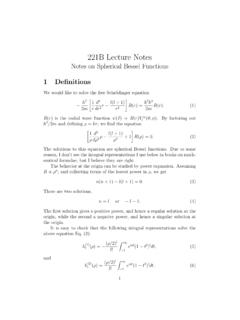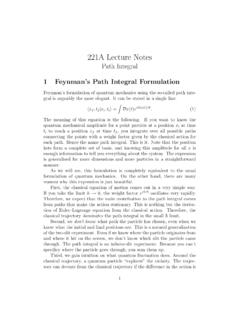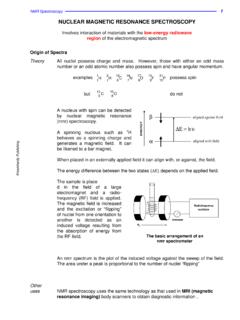Transcription of 221B Lecture Notes - Hitoshi Murayama
1 221b Lecture Notes Many-Body Problems IV. Nuclear Physics 1 Nuclei Nuclei sit at the center of any atoms. Therefore, understanding them is of central importance to any discussions of microscopic physics. Due to some reason, however, the nuclear physics had not been taught so much in the standard physics curriculum. I try to briefly review nuclear physics in a few lectures. Obviously I can't go into much details, but hope to give you at least a rough idea on nuclear physics. As you know, nuclei are composed of protons and neutrons. The number of protons is the atomic number Z, and the mass number A is approximately the total number of nucleons, a collective name for protons and neutrons.
2 Therefore A=N +Z (1). where N is the number of neutrons. We know that nuclei are very small. An empirical formula for the size of the nuclei, which can be measured using the form factor in elastic electron-nuclei scattering, is R = r0 A1/3 , r0 = fm. (2). This is a good approximation practically for all nuclei with A > 12. Here, 13. fm = 10 cm, or sometimes called also Fermi rather than femto-meter, and the nuclei are smaller by five orders of magnitude than the atoms. What the formula means is that the nuclear density is more-or-less constant for any nuclei, = 1038 nucleons/cm3 = nucleons/fm3 . Of course, the nuclear density does not drop to zero abruptly.
3 The form factor measurement is often fitted to the size and the surface thickness, within which the density smoothly falls from the constant to zero. The result is that the surface thickness is about t ' fm. 2 Empirical Mass Formula Gross properties of nuclei are manifested in the empirical (or Weizs acker). mass formula. Recall Einstein's relation E = mc2 , which tells us that the to- 1. Figure 1: From Theoretical Nuclear Physics, by Amos deShalit and Her- man Feshbach, New York, Wiley, 1974. 2. Figure 2: From Theoretical Nuclear Physics, by Amos deShalit and Her- man Feshbach, New York, Wiley, 1974. 3. Figure 3: A more realistic shape of nuclei.
4 From Subatomic Zoo, by Hans Frauenfelder and Ernest M. Henley, Prentice-Hall, Inc., NJ, 1974. 4. tal mass of nuclei has information on its composition as well as its interaction energies. The empirical mass formula is B. mnucleus (Z, N ) = Zmp + N mn , (3). c2. where the last term is the mass deficit due to the binding energy B, and is given by (Z N )2 Z2. B = av A as A2/3 asym aC 1/3 + (A). (4). A A. Among all these terms, the first terms is the most important one, giving roughly constant binding energy per nucleon. If you neglect all the other terms, the binding energy is roughly MeV/nucleon. But if you fit the data with all other terms, the number of course comes out differently.
5 We discuss each of the terms below. The first term is called the volume term with av = MeV, represent- ing that the total binding energy is roughly proportional to the number of nucleons. This is the dominant term in the formula. Other terms show the variation of the binding energy as a function of N and Z. The second term is called the surface term with as = MeV, representing that the binding energy is lost somehow proportional to the surface area. These two terms can be qualitatively explained by the so-called liquid drop model of nuclei. You can view a nucleus as a tightly packed drop of nucleons, each feeling attractive force from its neighbors.
6 The point is that the force comes basi- cally only from its neighbors due to the short-ranged nature of the nuclear force responsible for binding nuclei. Because the number of neighbors is basically the same for any nucleon given the constant nuclear density we've seen above, the amount of binding energy is proportional to the number of nucleons, giving rise to the volume term. This is said to be saturation of nuclear binding, and the nucleons basically don't see nucleons beyond their neighbors. But those at the surface receive less binding because they do not have about a half of neighbors. The loss of the binding energy is given by the surface term.
7 The symmetry term is less obvious. The empirical fact is that stable nuclei require more-or-less the same number of protons and neutrons, especially true for light nuclei. Think about common nuclides: 4 He, 12 C, 14 N, 16 O, etc, with high natural abundances. This point will be understood in terms of Fermi gas model of nuclei. By putting in neutrons and protons as free particles 5. Figure 4: Nuclear binding energy is more-or-less independent of its size, roughly about MeV/nucleon. The first few peaks are for 4 He, 12 C, 16 O. The maximum is for 56 Fe. From Theoretical Nuclear Physics, by Amos deShalit and Herman Feshbach, New York, Wiley, 1974.
8 6. in a Fermi-degenerate gas, protons and neutrons fill up levels independently, and it is energetically favorable to keep the Fermi energies for protons and neutrons the same for a given total number of nucleons (mass number). The symmetry term, with asym = MeV, reflects the rise in the energy when they are not equal with a parabolic approximation around the minimum Z = N. The Coulomb term has the obvious meaning of total Coulomb energy among protons (neutrons are electrically neutral!). Because the number of protons is Z, and there is Coulomb potential between any pairs of protons (long-ranged force unlike the nuclear binding force), the energy goes as Z 2.
9 The typical distance among them is the nuclear size, given by A1/3 , hence the dependence Z 2 /A1/3 , with the coefficient aC = MeV. It shows that the Coulomb interaction is actually a very weak interaction compared to the nuclear force. Of course, the actual size of the Coulomb energy can be important especially for large nuclei, because it grows like Z 2 (even if you scale Z and A together, it grows as Z 5/3 ). This tends to prefer smaller Z for a given A. The competition of the Coulomb term and the symmetry term gives a preferred fraction of protons for a given A, which becomes smaller and smaller as A increases, consistent with the observed band of stable isotopes.
10 Finally the last term is called the pairing term. There is a tendency that nucleons want to be paired between a given state and its time-reversed state, , the opposite orbital and spin angular momenta. Because of this property, even-even nuclei (nuclei with even number of protons and even number of neutrons) have all 0+ ground state. There is a sizable difference in the binding energies between nuclei with all nucleons paired (even-even ones) and those with some nuclei unpaired (even-odd, odd-even, and odd- odd). The pairing term represents the energy difference among them, given by 3/4.. 34A. MeV for odd-odd nuclei (A) = 0 MeV for odd-even nuclei.





